Field Pumping and Recharge Test Study for Confined Aquifers in Super-Large Deep Foundation Pit Group Sites
Abstract
1. Introduction
2. Project Background
2.1. Project Overview
2.2. Hydrogeological Conditions
3. Field Pumping and Recharge Test
3.1. Test Well and Monitoring Point
3.2. Test Scheme
4. Analysis of Single-Well Pumping Test Results
4.1. Temporal Development of Groundwater Drawdown
4.2. Spatial Distribution of Groundwater Drawdown
4.3. Single-Well Influence Radius
5. Analysis of Multi-Well Pumping Test Results
5.1. Ground Surface Settlement
5.2. Deep Soil Settlement
5.3. Hydraulic Conductivity Inversion
6. Analysis of Recharge Test Results
6.1. Groundwater Drawdown
6.2. Soil Settlement
7. Conclusions
- (1)
- A certain hydraulic connectivity exists between the 7th and 9th layers at the site, with strong hydraulic recharge between these two aquifers. The groundwater rapidly recovers once pumping is stopped. Therefore, during subsequent foundation pit construction, pumping should not be interrupted and a backup pumping well should be provided. The 5th layer in the paleochannel zone exhibits poor hydraulic recharge, allowing pumping interruptions to be controlled within 20 min. The aquitard between the 5th and 7th layers in the paleochannel zone is insufficient to completely block hydraulic connectivity, resulting in leakage between these two layers.
- (2)
- Ground surface settlement significantly lags behind groundwater variations in both the normally consolidated zone and paleochannel zone. Although settlement decreases after groundwater recovery, the settlement recovery rate reaches only 20%, indicating 80% plastic deformation. The ratio of ground surface settlement to groundwater drawdown remains consistent in both zones at approximately 3.4 mm/m.
- (3)
- Soil settlement in the overlying aquitard caused by confined aquifer dewatering is comparable to or even greater than ground surface settlement. Therefore, attention should not be limited solely to surface settlement. In particular, when existing underground structures are present above the de-pressurized aquifer, it is necessary to increase the monitoring frequency of the settlement and structural behavior at the top of the de-pressurized aquifer.
- (4)
- Both the normally consolidated zone and the paleochannel zone can employ recharge to control or even reduce settlement resulting from groundwater drawdown. However, relying solely on recharge cannot fully address the differential settlement along depth caused by pumping. During design and construction, comprehensive consideration should be paid to target dewatering depth, ground settlement control, and deformation requirements of protected structures to ensure both the safety and cost-effectiveness of the dewatering–recharge scheme.
Author Contributions
Funding
Data Availability Statement
Conflicts of Interest
References
- Li, X.; Liu, T.; Ju, S.; Guo, Y. Optimization and Impact Assessment of Excavation Sequence around Subway Stations from the Perspective of Sustainable Urban Development. Buildings 2024, 14, 1767. [Google Scholar] [CrossRef]
- Oka, F.; Takada, N.; Shimono, K.; Higo, Y.; Kimoto, S. A Large-Scale Excavation in Soft Holocene Deposit and Its Elasto-Viscoplastic Analysis. Acta Geotech. 2016, 11, 625–642. [Google Scholar] [CrossRef]
- Li, M.G.; Chen, J.J.; Xia, X.H.; Zhang, Y.Q.; Wang, D.F. Statistical and Hydro-Mechanical Coupling Analyses on Groundwater Drawdown and Soil Deformation Caused by Dewatering in a Multi-Aquifer-Aquitard System. J. Hydrol. 2020, 589, 125365. [Google Scholar] [CrossRef]
- Zeng, C.F.; Wang, S.; Xue, X.L.; Zheng, G.; Mei, G.X. Evolution of Deep Ground Settlement Subject to Groundwater Drawdown during Dewatering in a Multi-Layered Aquifer-Aquitard System: Insights from Numerical Modelling. J. Hydrol. 2021, 603, 127078. [Google Scholar] [CrossRef]
- Liu, B.; Zhang, D.W.; Wang, Y.Y.; Wang, N.N.; Xu, W. Design Optimization and Observed Performance of a Super-Large Foundation Pit Excavation Subjected to Unsymmetrical Loading in Water-Rich Floodplain: A Case Study. Soils Found. 2023, 63, 101329. [Google Scholar] [CrossRef]
- Liu, Y.; Xiang, B.H.; Fu, M.F. Observed Performance of a Large-Scale Deep Triangular Excavation in Shanghai Soft Clays. Geotech. Geol. Eng. 2019, 37, 2791–2809. [Google Scholar] [CrossRef]
- Lei, H.Y.; Zhan, B.S.; Feng, S.X.; Amin, M. Influence of Foundation Pit Groups’ Excavation on the Deformation Characteristics of Adjacent Railway Subgrade and Protection Measures. Geotech. Geol. Eng. 2023, 41, 3877–3895. [Google Scholar] [CrossRef]
- Pujades, E.; Jurado, A. Groundwater-Related Aspects during the Development of Deep Excavations below the Water Table: A Short Review. Undergr. Space 2021, 6, 35–45. [Google Scholar] [CrossRef]
- Zhang, D.M.; Xie, X.C.; Zhou, M.L.; Huang, Z.K.; Zhang, D.M. An Incident of Water and Soil Gushing in a Metro Tunnel Due to High Water Pressure in Sandy Silt. Eng. Fail. Anal. 2021, 121, 105196. [Google Scholar] [CrossRef]
- Chen, Z.; Huang, J.T.; Zhan, H.B.; Wang, J.G.; Dou, Z.; Zhang, C.J.; Chen, C.S.; Fu, Y.S. Optimization Schemes for Deep Foundation Pit Dewatering under Complicated Hydrogeological Conditions Using MODFLOW-USG. Eng. Geol. 2022, 303, 106653. [Google Scholar] [CrossRef]
- Peng, C.X.; Liu, N.W.; Li, M.G.; Zhen, L.; Chen, J.J. Hydro-Mechanical Coupled Analyses on Wall Deformations Caused by Deep Excavations and Dewatering in a Confined Aquifer. Acta Geotech. 2022, 17, 2465–2479. [Google Scholar] [CrossRef]
- Deng, Y.S.; Guo, Y.J.; Zou, B.P.; Wang, J.X.; Liu, X.T.; Chen, Q.Z.; Kong, B.W.; Liang, S.J. Failure Analysis and Zoning Control of Water Gushing in Foundation Pit. Eng. Fail. Anal. 2023, 145, 107029. [Google Scholar] [CrossRef]
- Chu, Y.; Shi, J.; Ye, Z.; Liu, D. Dewatering Characteristics and Drawdown Prediction of Suspended Waterproof Curtain Foundation Pit in Soft Soil Areas. Buildings 2024, 14, 119. [Google Scholar] [CrossRef]
- Xu, Y.S.; Shen, S.L.; Ma, L.; Sun, W.J.; Yin, Z.Y. Evaluation of the Blocking Effect of Retaining Walls on Groundwater Seepage in Aquifers with Different Insertion Depths. Eng. Geol. 2014, 183, 254–264. [Google Scholar] [CrossRef]
- Wu, Y.X.; Shen, S.L.; Yuan, D.J. Characteristics of Dewatering Induced Drawdown Curve under Blocking Effect of Retaining Wall in Aquifer. J. Hydrol. 2016, 539, 554–566. [Google Scholar] [CrossRef]
- Zhou, N.Q.; Vermeer, P.A.; Lou, R.X.; Tang, Y.Q.; Jiang, S.M. Numerical Simulation of Deep Foundation Pit Dewatering and Optimization of Controlling Land Subsidence. Eng. Geol. 2010, 114, 251–260. [Google Scholar] [CrossRef]
- Zhang, Y.Q.; Li, M.G.; Wang, J.H.; Chen, J.J.; Zhu, Y.F. Field Tests of Pumping-Recharge Technology for Deep Confined Aquifers and Its Application to a Deep Excavation. Eng. Geol. 2017, 228, 249–259. [Google Scholar] [CrossRef]
- Pujades, E.; De Simone, S.; Carrera, J.; Vázquez-Suñé, E.; Jurado, A. Settlements around Pumping Wells: Analysis of Influential Factors and a Simple Calculation Procedure. J. Hydrol. 2017, 548, 225–236. [Google Scholar] [CrossRef]
- Zhou, X.J.; Burbey, T.J. Deformation Characteristics of a Clayey Interbed during Fluid Injection. Eng. Geol. 2014, 183, 185–192. [Google Scholar] [CrossRef]
- Zhang, Y.Q.; Wang, J.H.; Chen, J.J.; Li, M.G. Numerical Study on the Responses of Groundwater and Strata to Pumping and Recharge in a Deep Confined Aquifer. J. Hydrol. 2017, 548, 342–352. [Google Scholar] [CrossRef]
- Zheng, G.; Cao, J.R.; Cheng, X.S.; Ha, D.; Wang, F.J. Experimental Study on the Artificial Recharge of Semiconfined Aquifers Involved in Deep Excavation Engineering. J. Hydrol. 2018, 557, 868–877. [Google Scholar] [CrossRef]
- Zeng, C.F.; Zheng, G.; Xue, X.L. Responses of Deep Soil Layers to Combined Recharge in a Leaky Aquifer. Eng. Geol. 2019, 260, 105263. [Google Scholar] [CrossRef]
- Zeng, C.F.; Liao, H.; Xue, X.L.; Long, S.C.; Luo, G.J.; Diao, Y.; Li, M.G. Responses of Groundwater and Soil to Dewatering Considering the Barrier Effect of Adjacent Metro Station on Multi-Aquifers. J. Hydrol. 2022, 612, 128117. [Google Scholar] [CrossRef]
- Li, M.G.; Zhang, Z.J.; Chen, J.J. Zoned and Staged Construction of an Underground Complex in Shanghai Soft Clay. Tunn. Undergr. Space Technol. 2017, 67, 187–200. [Google Scholar] [CrossRef]
- Zeng, C.F.; Wang, S.; Xue, X.L. Characteristics of Ground Settlement Due to Combined Actions of Groundwater Drawdown and Enclosure Wall Movement. Acta Geotech. 2022, 17, 4095–4112. [Google Scholar] [CrossRef]
- Xu, Y.S.; Yan, X.X.; Shen, S.L.; Zhou, A.N. Experimental Investigation on the Blocking of Groundwater Seepage from a Waterproof Curtain during Pumped Dewatering in an Excavation. Hydrogeol. J. 2019, 27, 2659–2672. [Google Scholar] [CrossRef]
- Wang, J.X.; Liu, X.T.; Wu, Y.B.; Liu, S.L.; Wu, L.G.; Lou, R.X.; Lu, J.S.; Yin, Y. Field Experiment and Numerical Simulation of Coupling Non-Darcy Flow Caused by Curtain and Pumping Well in Foundation Pit Dewatering. J. Hydrol. 2017, 549, 277–293. [Google Scholar] [CrossRef]
- Shen, S.L.; Xu, Y.S. Numerical Evaluation of Land Subsidence Induced by Groundwater Pumping in Shanghai. Can. Geotech. J. 2011, 48, 1378–1392. [Google Scholar] [CrossRef]
- Li, X.W.; Xu, Y.S.; Wang, X.W. Analysis of Factors Affecting the Groundwater Level during Foundation Pit Dewatering in the Soft Soil Area: A Review. Environ. Earth Sci. 2024, 83, 526. [Google Scholar] [CrossRef]

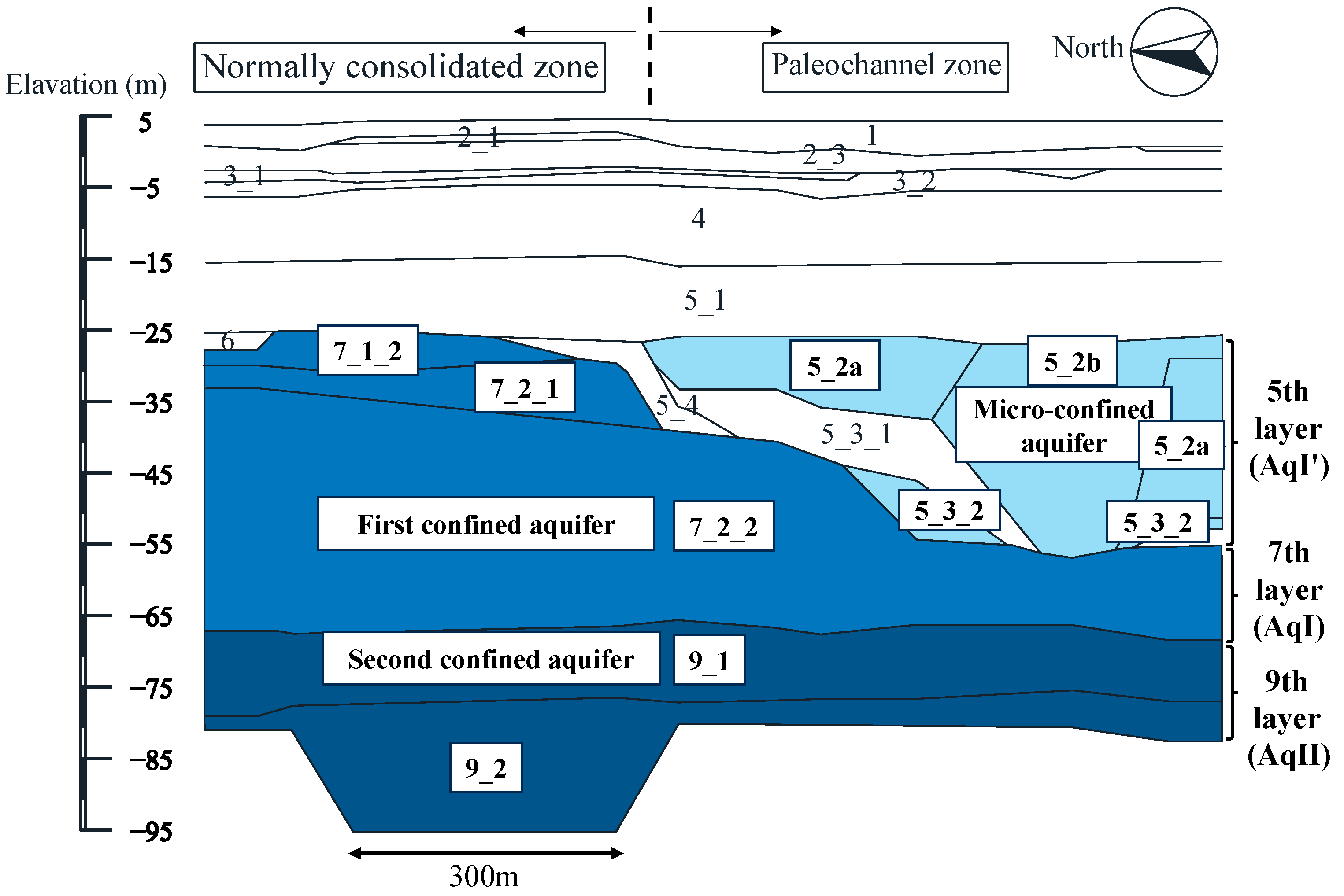


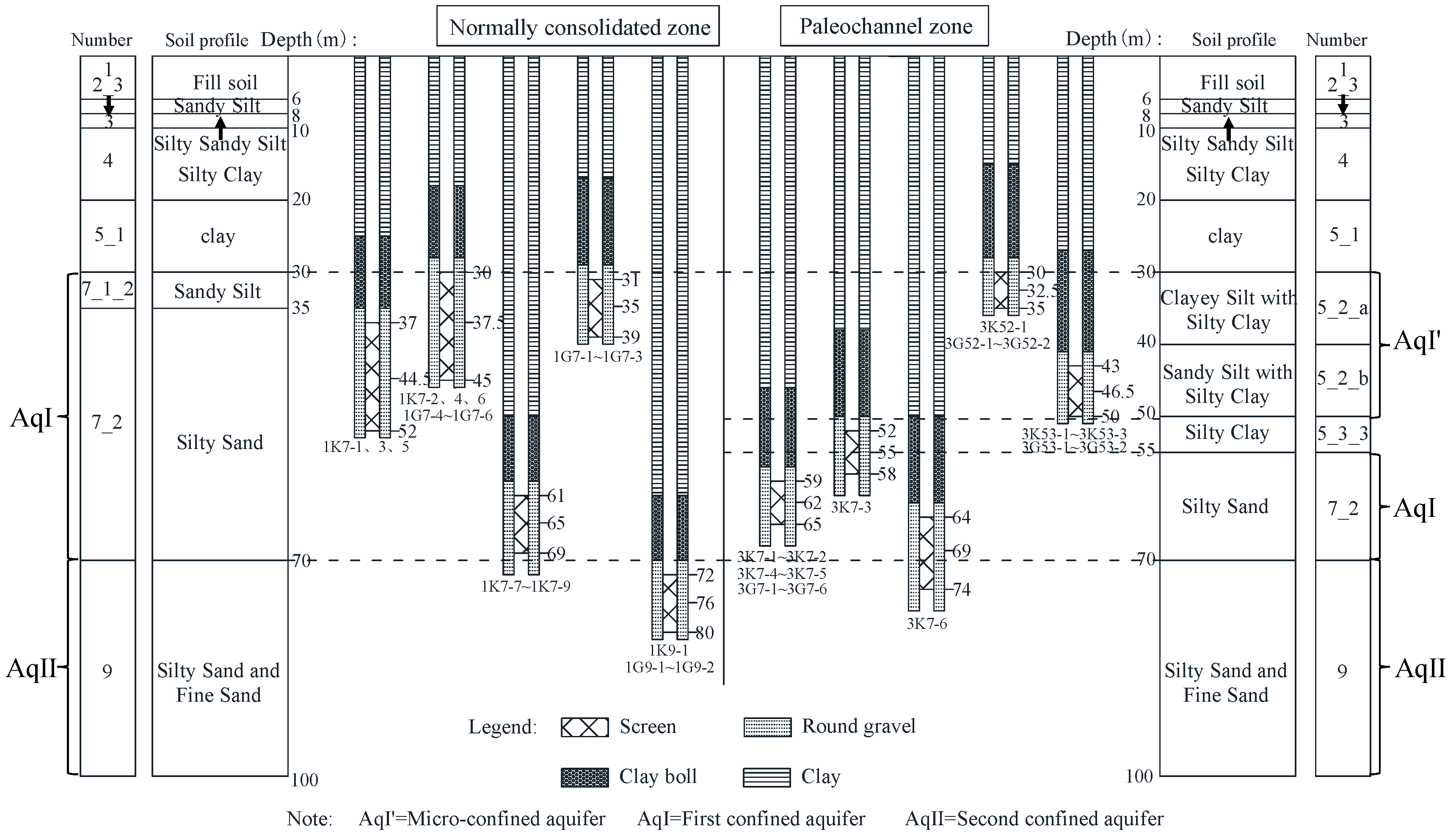

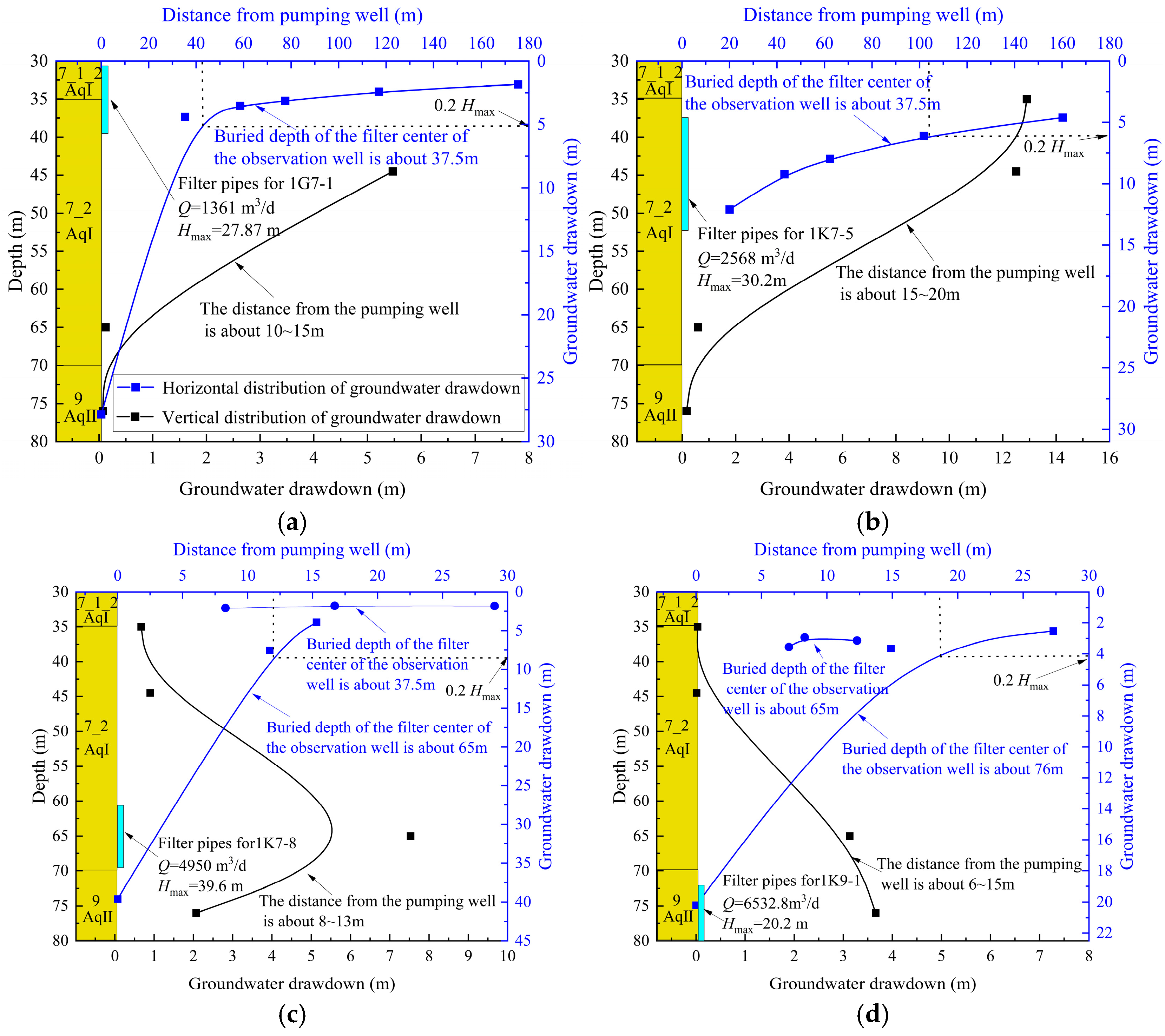
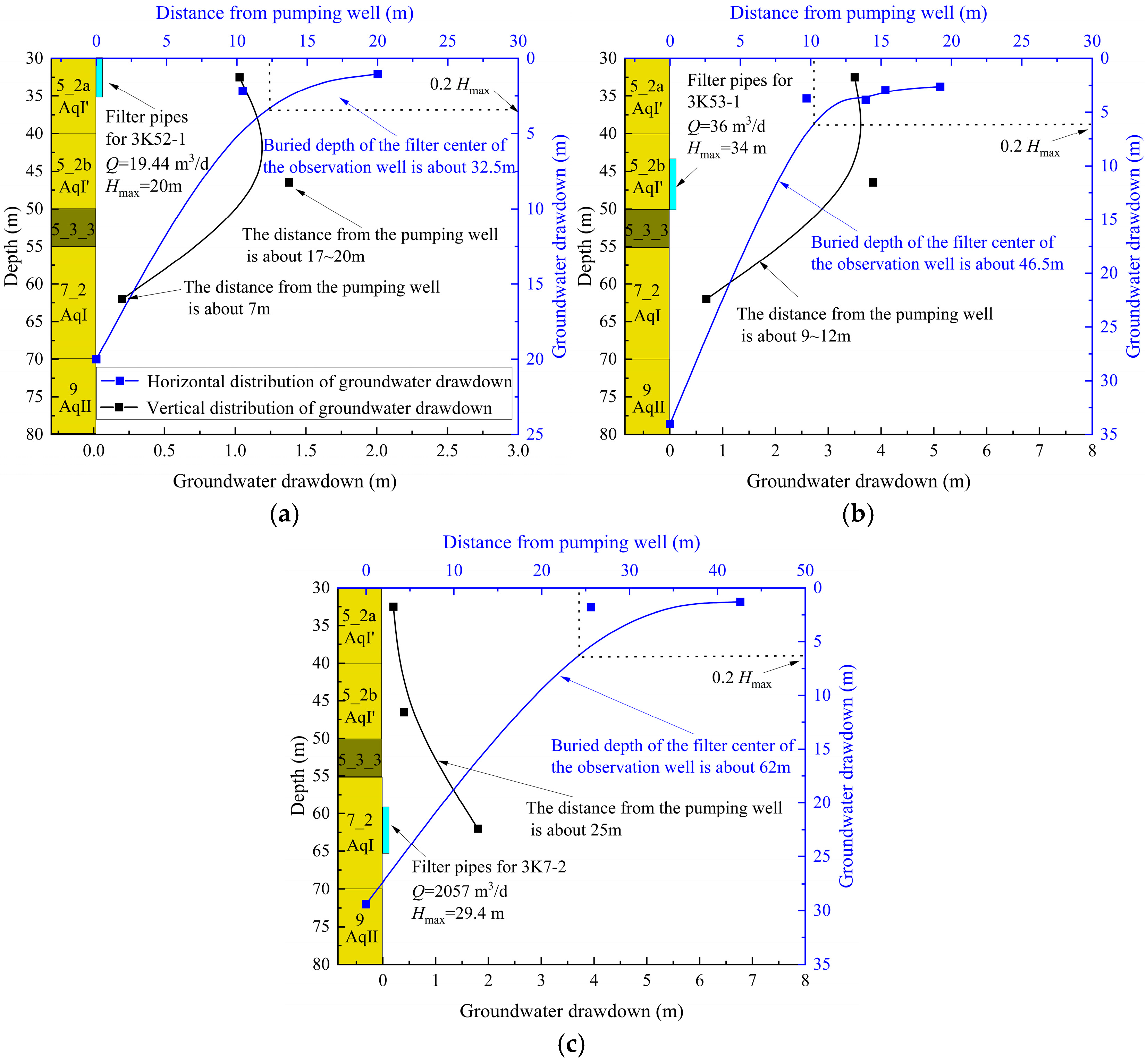
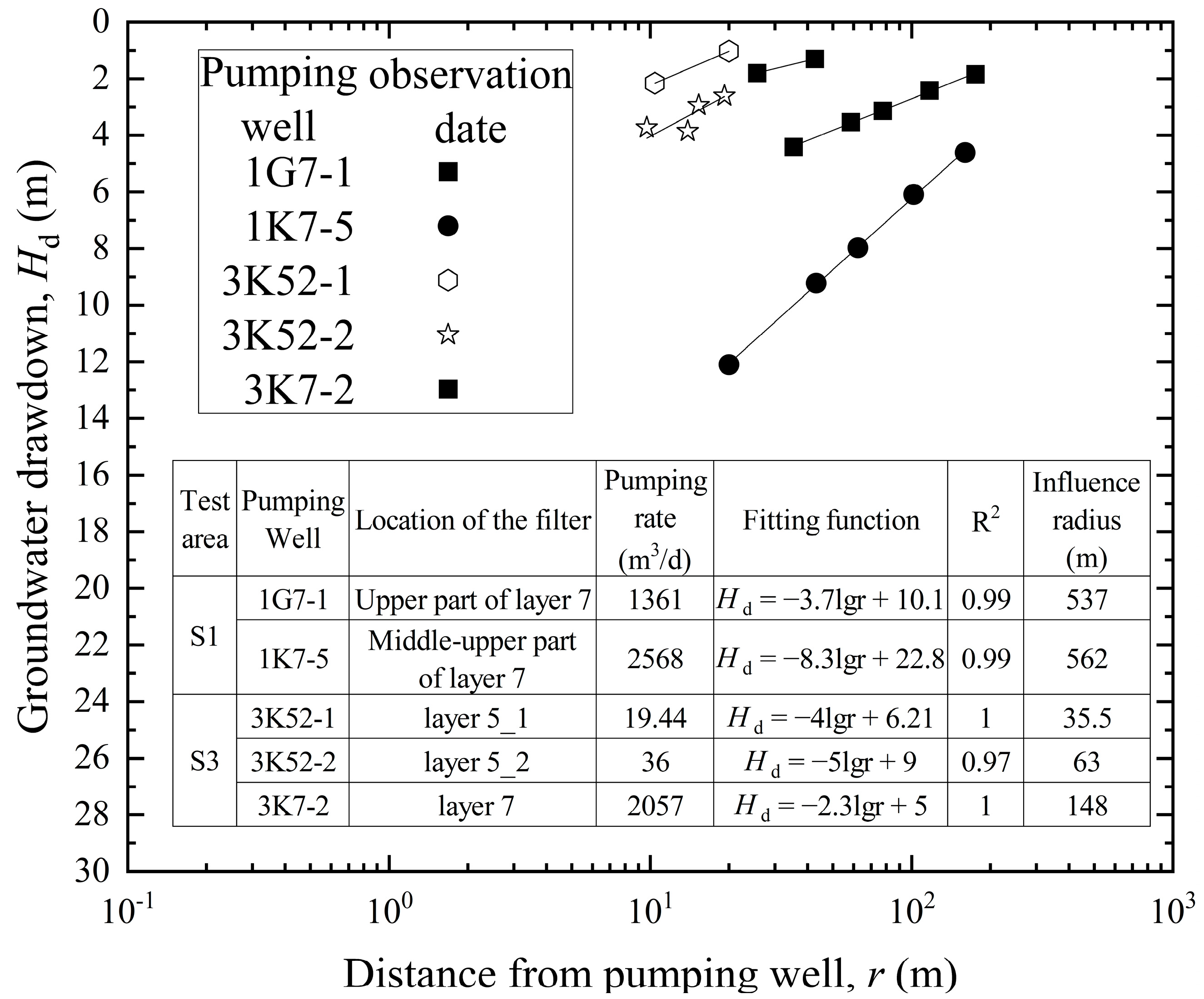
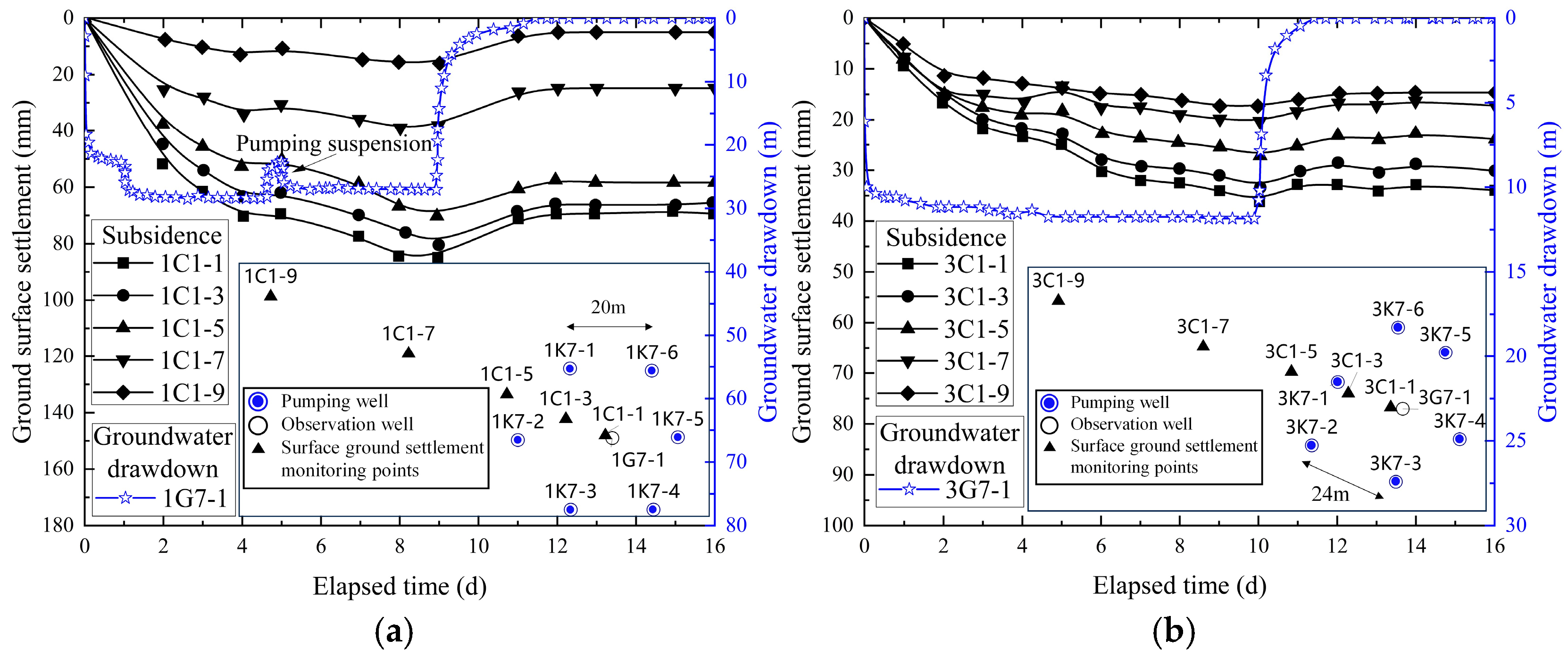
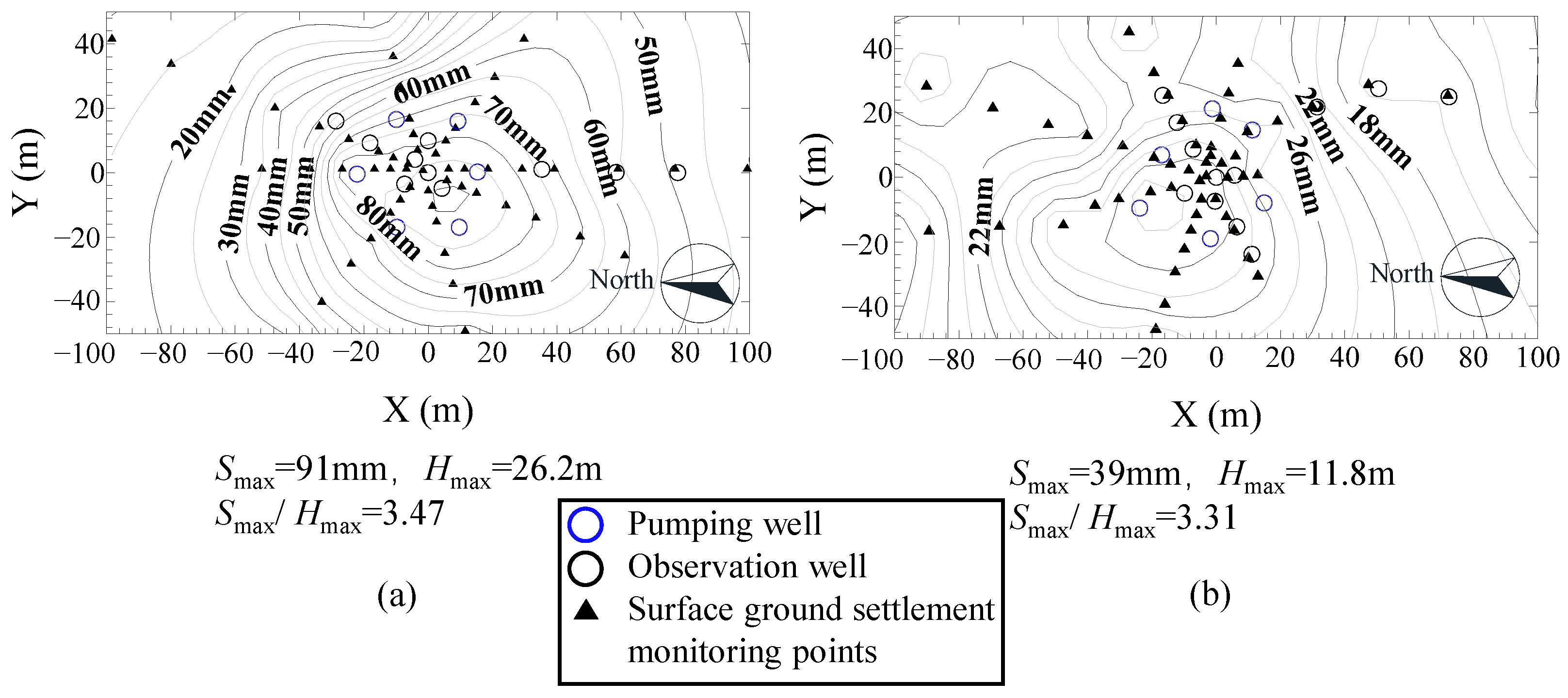
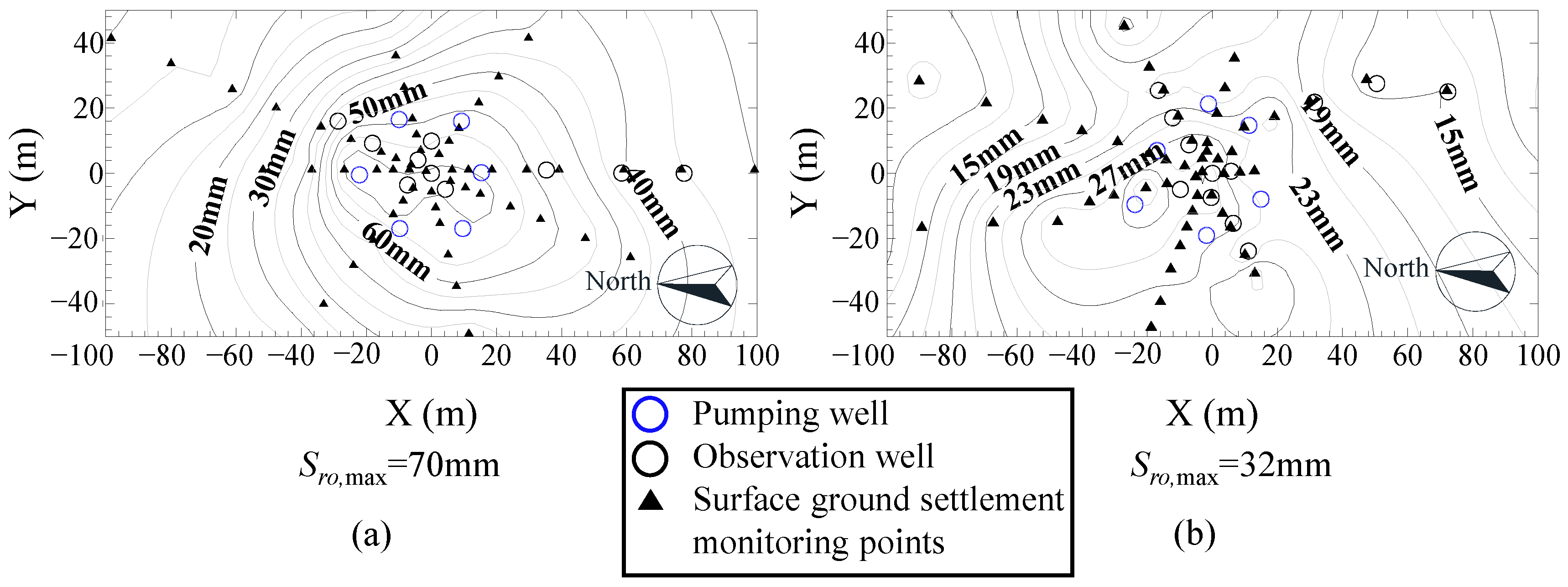

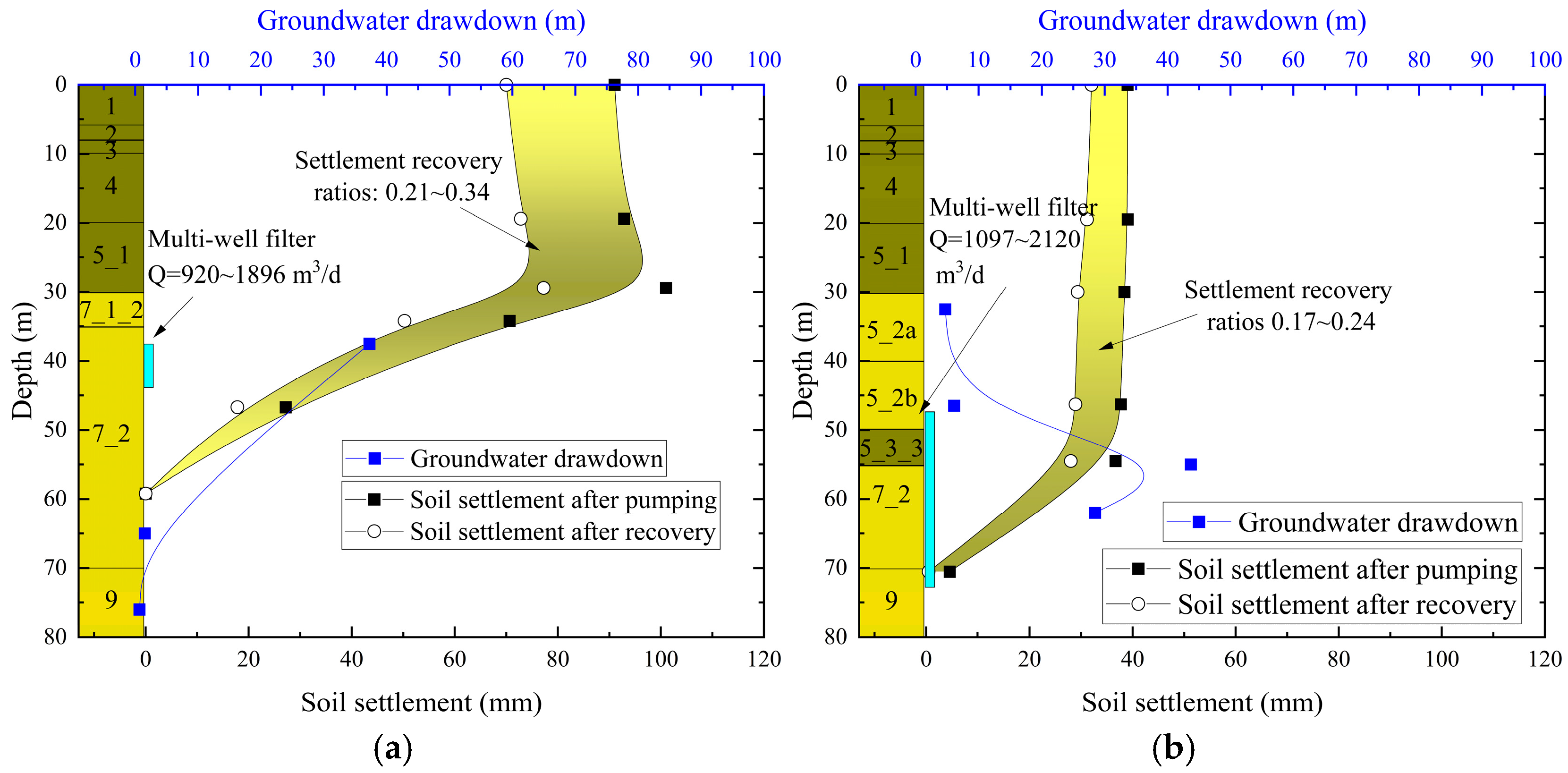


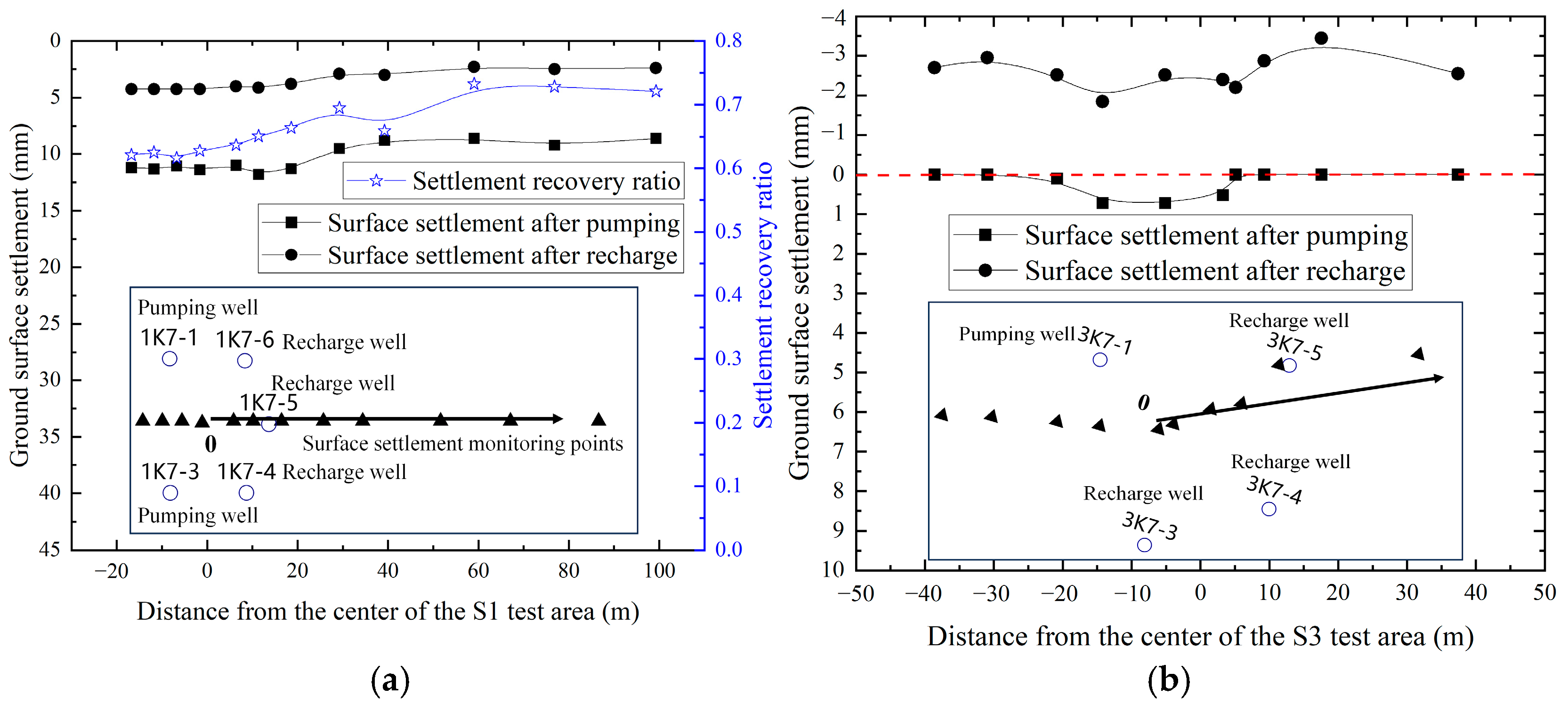

| Test Area | Test Stage | Pumping Well | Duration (d) | ||
|---|---|---|---|---|---|
| Total | Pumping | Recovery | |||
| S1 (Normally consolidated zone) | Single-well pumping test | 1G7-1 (Upper 7th Layer) | 3 | 1.5 | 1.5 |
| 1K7-5 (Mid-upper 7th Layer) | |||||
| 1K7-8 (Deep 7th Layer) | |||||
| 1K9-1 (9th Layer) | |||||
| Multi-well pumping tests | 1K7-1~1K7-6 | 16 | 9 | 7 | |
| S3 (Paleochannel zone) | Single-well pumping test | 3K52-1 | 5 | 2.2 | 2.8 |
| 3K53-1 | 6 | 3.2 | 2.8 | ||
| 3K7-2 | 3 | 1 | 2 | ||
| Multi-well pumping tests | 3K7-1~3K7-6 | 17 | 10 | 7 | |
| Test Area | Pumping Well | Recharge Well | Pumping Duration (d) | Pumping–Recharge Duration (d) |
|---|---|---|---|---|
| S1 (Normally consolidated zone) | 1K7-1, 1K7-3 | 1K7-4~1K7-6 | 1 | 1 |
| S3 (Paleochannel zone) | 3K7-1 | 3K7-3~3K7-5 | 1 | 1 |
Disclaimer/Publisher’s Note: The statements, opinions and data contained in all publications are solely those of the individual author(s) and contributor(s) and not of MDPI and/or the editor(s). MDPI and/or the editor(s) disclaim responsibility for any injury to people or property resulting from any ideas, methods, instructions or products referred to in the content. |
© 2025 by the authors. Licensee MDPI, Basel, Switzerland. This article is an open access article distributed under the terms and conditions of the Creative Commons Attribution (CC BY) license (https://creativecommons.org/licenses/by/4.0/).
Share and Cite
Wang, S.; Wang, W.; Xu, Z.; Song, Q.; Qian, J. Field Pumping and Recharge Test Study for Confined Aquifers in Super-Large Deep Foundation Pit Group Sites. Buildings 2025, 15, 1383. https://doi.org/10.3390/buildings15081383
Wang S, Wang W, Xu Z, Song Q, Qian J. Field Pumping and Recharge Test Study for Confined Aquifers in Super-Large Deep Foundation Pit Group Sites. Buildings. 2025; 15(8):1383. https://doi.org/10.3390/buildings15081383
Chicago/Turabian StyleWang, Shuo, Weidong Wang, Zhonghua Xu, Qingjun Song, and Jiangu Qian. 2025. "Field Pumping and Recharge Test Study for Confined Aquifers in Super-Large Deep Foundation Pit Group Sites" Buildings 15, no. 8: 1383. https://doi.org/10.3390/buildings15081383
APA StyleWang, S., Wang, W., Xu, Z., Song, Q., & Qian, J. (2025). Field Pumping and Recharge Test Study for Confined Aquifers in Super-Large Deep Foundation Pit Group Sites. Buildings, 15(8), 1383. https://doi.org/10.3390/buildings15081383






